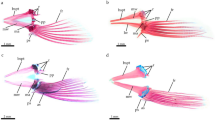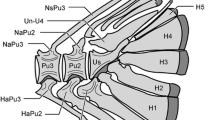Abstract
Observations of the vertebrae of three genera and five species of neoscopelid fishes revealed the presence of two series of parapophyses (a ventral series and a lateral foveal series). The ventral parapophyses, situated on the ventral surface of the centra, were present on only the anterior abdominal vertebrae (AV): inScopelengys (AV1, 2),Neoscopelus (AV1–6 or 7),Solivomer (AV1–8). Parapophyses on the first vertebra were ossified, cone-shaped enlargements, the remainder being small, cartilaginous and ovalshaped. The lateral foveal parapophyses were formed from an extension of the lower edges of the foveae on the lateral surfaces of the centra, into which the ribs are set, being developed caudally to form the hemal arches: inScopelengys (AV4 posteriorly),Neoscopelus (AV6 or 7 posteriorly),Solivomer (AV8 posteriorly). The last ventral cartilaginous parapophyses and first lateral foveal parapophyses were present on the same centrum in two genera,Neoscopelus (AV6 or 7) andSolivomer (AV8). Lateral foveal parapophyses series were also found in some acanthomorphs and a ventral parapophyses series in some non-acanthomorphs. Whereas the ventral papapophyses in the non-acanthomorphs developed posteriorly to form the hemal arches, this parapophyses series in neoscopelids is incomplete, being absent on the posterior abdominal vertebrae. This suggests that the ventral parapophyses series in neoscopelids seems to be a remnant of that in the non-acanthomorphs. In myctophids, although cartilaginous ventral parapophyses were absent posteriorly from the second vertebra, enlarged ossified cone-shaped parapophyses on the first vertebra (as in neoscopelids) and lateral foveal parapophyses usually from the third vertebra were present. Accordingly, myctophids appear to be similar to neoscopelids in having two types of parapophyses.
Similar content being viewed by others
Literature Cited
Borodulina, O. D. 1987. Identification of the remains of mesopelagic fishes. VI. Features of the axial skeleton of myctophoid fishes (Myctophoidea). J. Ichthyol., 27: 170–174.
Clothier, C. R. 1950. A key to some southern California fishes based on vertebral characters. Calif. Div. Fish and Game, Fish Bull, (79): 1–83.
Ford, E. 1937. Vertebral variation in teleostean fishes. J. Mar. Biol. Assoc., 22: 1–60, 16 pls.
Hotta, H. 1961. Comparative study of the axial skeleton of Japanese teleostei, Nippon Gyogaku Shinkokai, Tokyo, Japan. ii+155 pp., 69 pls. (In Japanese with English abstract.)
Leviton A. E., R. H. Gibbs, Jr., E. Heal and C. E. Dawson. 1985. Standards in herpetology and ichthyology: part I. Standard symbolic codes for institutional resource collections in herpetology and ichthyology. Copeia, 1985: 802–832.
Matsuoka, M. 1997. Osteological development in the Japanese sardine,Sardinops melanostictus. Ichthyol. Rec., 44: 275–295.
Nafpaktitis, B. G. 1977. Family Neoscopelidae. Pages 1–12in R. H. Gibbs, Jr., F. H. Berry, J. E. Bohlke, D. M. Cohen, B. B. Collette, W. N. Eschmeyer, G. W. Mead, D. Merriman and T. W. Pietsch, eds. Fishes of the western North Atlantic, part seven, order Iniomi (Myctophiformes). Sears Found. Mar. Res., Mem. No. 1, Part 7. Yale University, New Haven.
Nelson, J. S. 1994. Fishes of the world 3rd edition. John Wiley & Sons, Inc., New York, USA. xvii+600 pp.
Potthoff, T. 1984. Clearing and staining techniques. Pages 35–37in H. G. Moser, W. J. Richards, D. M. Cohen, M. P. Fahay, A. W. Kendall, Jr. and S. L. Richardson, eds. Ontogeny and systematics of fishes. Am. Soc. Ichthyol. Herpetol. Spec. Publ. 1.
Potthoff, T., S. Kelley and A. Collins. 1988. Osteological development of the red snapper,Lutjanus campechanus (Lutjanidae). Bull. Mar. Sci., 43: 1–40.
Rosen, D. E. 1973. Interrelationships of higher euteleostean fishes. Pages 397–513.in P. H. Greenwood, R. S. Miles and C. Patterson, eds. Interrelationships of fishes. Academic Press, London.
Stiassny, M. L. J. 1986. The limits and relationships of the acanthomorph teleosts. J. Zool. London, (B), 1: 411–460.
Stiassny, M. L. J. 1996. Basal ctenosquamate relationships and the interrelationships of the myctophiform (Scopelomorph) fishes. Pages 405–426in M. L. J. Stiassny, L. R. Parenti and G. D. Johnson, eds. Interrelationships of fishes. Academic Press, San Diego.
Takahashi, Y. 1962. Study for the identification of species based on the vertebral column of teleostei in the inland sea and its adjacent waters. Bull. Naikai Reg. Fish. Res. Lab., (16): 1–74, 122 pls. (In Japanese with English abstract.)
Author information
Authors and Affiliations
About this article
Cite this article
Miyashita, T., Fujita, K. Two series of parapophyses in neoscopelid fishes (teleostei: Myctophiformes). Ichthyological Research 47, 143–148 (2000). https://doi.org/10.1007/BF02684234
Received:
Revised:
Accepted:
Published:
Issue Date:
DOI: https://doi.org/10.1007/BF02684234




